As fun as it can be, Star Wars is a pretty fraught universe. We don’t always talk about that because unpacking the vast amount of carnage and destitution is a pretty tall order for a franchise that is largely thought of as popcorn entertainment by the masses. But we also don’t really talk about it because most Star Wars stories are Big Picture ones. They are about the Most Important People doing the Most Important Things in the universe. And that typically comes with a lot of sadness and scale and scope.
Which is why it’s totally understandable that you might have missed Star Wars: Rebels bringing that galaxy far, far away down to earth.
To be fair, the characters in Rebels are not playing for small beans. These are some of the initial operatives that form what later becomes the lauded Rebel Alliance. What they do matters and will affect future generations. But in a universe where every major reveal revolves around secret family members or legends stepping out into the light of day or the fate of the galaxy, it’s hard to find simpler relationships, or see characters taking the time to simply relate to one another.
This is particularly hilarious because family crew stories are pretty much the bread and butter of science fiction. One captain, a team of misfits, a nasty bad guy to occasionally lock horns with? That’s the cream filling of the space donut. Or the jelly if you don’t like cream. Or frosting. The point is, it’s what makes the donut delicious. But Star Wars never really leaned on those narratives until the Ghost showed up.
The Ghost is the ship of Hera Syndulla, probably the greatest pilot in the Star Wars universe. (Yes, over Han Solo. Yes, even over Force-powered cyclone Anakin Skywalker; Hera outmaneuvers Vader in her tenure on the show, and that’s without any fancy Force powers helping her out.) Its crew is her family, and that family is made up of a former Jedi Padawan who fled Order 66, his teenaged amateur con artist apprentice, a Mandalorian munitions expert slash guerrilla artist, a former member of the lasat Honor Guard who watched genocide get carried out against his people, and a war hero R4 unit who served in the Clone Wars. Together, they form one of the best space families television has ever had to offer.
If you haven’t been watching Rebels, you should be. And you’re in luck—since it’s coming to an end next week, you can binge-watch the whole thing from start to finish. Here are just a few things that you have to look forward to, or have probably enjoyed if you’ve been watching the whole time.
Jedi—and the Force—Are a Little Different This Time Around
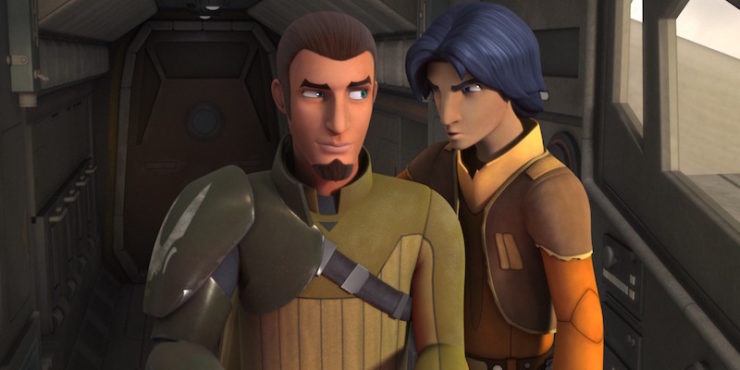
Star Wars stories are most often about the Jedi and the Force. Even when they focus on other people, the question of where Force-users are and what they’re doing is always going to linger on people’s minds. But so far, the stories we have seen are primarily concerned with the Skywalker family and people adjacent to them. Most of these people are the most powerful Force-users in the galaxy, and every choice they make will cause major repercussions for the Force and how it is used/perceived down the road.
And then there’s Kanan Jarrus and his apprentice Ezra Bridger.
Kanan was Padawan to Depa Billaba in the final days of the Clone Wars, and he finds fourteen-year-old Ezra living alone on the streets of Lothal at the start of the show. Hera pushes him to take Ezra on as an apprentice, and series spends a great deal of time examining Ezra’s journey as Kanan’s student. Thing is… Kanan’s not a Jedi. Or at least, he isn’t when he starts training the plucky kid. In fact, Kanan has been hiding in plain sight for about a decade, lightsaber modified so that he can store it in two separate pieces to avoid detection. He never completed his training, so he’s just doing the best he can with Ezra.
Sure, Luke Skywalker got the Cliffsnotes version of Jedi training, but there was a lot riding on him. Obi-Wan and Yoda expected him to do as he was told, to follow their directions and take every lesson to heart. Kanan and Ezra are pretty much the definition of “winging it” alongside that. Half the time, when Kanan spouts a Jedi parable and Ezra questions it, Kanan has to admit that he’s not really sure what it meant in the first place.
As a result, the Jedi training that Ezra and Kanan engage in is surprisingly less stressful than most of what we’ve seen. Even Ahsoka Tano’s training under Anakin Skywalker contained a fundamental urgency, completely wrapped up in a dire war with enemies acting in every corner. But when Ezra briefly flirts with the Dark Side after meeting Darth Maul? It’s… mostly fine. Kanan tells him he should be more careful and remember not to act out of anger, and Ezra lets it go. We realize that there’s some wiggle room in the Force, that every deed or mistake is not a harbinger of doom.
Because Kanan cannot functionally be a Jedi of the old Order, he’s far more flexible than his felled brethren. Creator Dave Filoni has called him a “cowboy Jedi,” but that shorthand isn’t really what makes Kanan Jarrus special. What does is that fact that he’s kind of a goofy dad. He instructs Ezra, and he teaches the Ghost’s Mandalorian protégée Sabine. He keeps people calm and bolsters them when they need a shoulder to cry on or someone to vent at. He is kind, supportive, and compassionate. In fact, when Kanan admits to Ezra that he’s pretty sure he’s run out of things to teach the kid about the Force, Ezra points out that the real reason he wants to stay with Kanan is because his Jedi Master is more responsible for emotional and moral development: “I need you to teach me how to be a good person.”
Yeah, did I mention that this show was really about a space family? Because that’s what the Force gets wrapped up in too, where Rebels is concerned. Papa Kanan trying to teach his kids to not murder (Sabine) and not let their emotions rule them (Ezra) and generally messing up along the way. It makes the Force personal and in some ways far more interesting. Because most of the beings who can feel the Force were never members of the Jedi Council, or people with the last name Skywalker. Most of them are just people.
Some of Your Favorite People From The Clone Wars Are Always Hanging Around
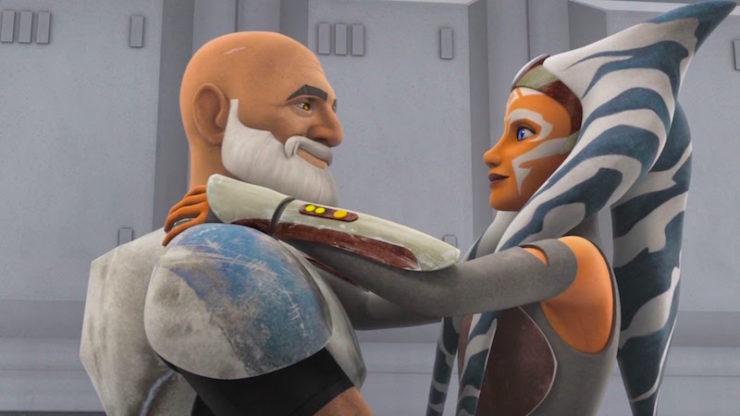
If you missed Ahsoka Tano, Rex, or Hondo Onaka, Star Wars: Rebels is here for you. They know that many of the fans from the last series carried over, and you get to spend ample time with friendly faces. Not only does this help carry a sense of continuity without over-relying on film characters (though you get to see Leia, Vader, Obi-Wan, Darth Maul, and more as well), but it makes the timeline connect a bit more fluidly. Rebels begins about 14 years after Episode III, so seeing where some of the survivors of the Clone Wars end up is helpful in the transition between the multitude of narratives that Star Wars always contains.
It’s Hera Syndulla’s Universe and We’re All Just Living in It
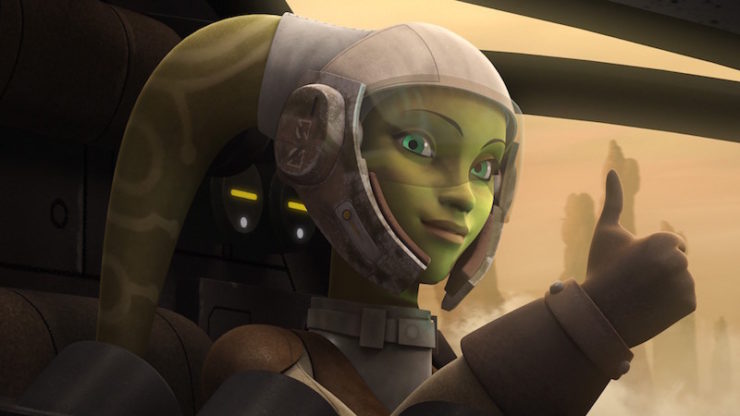
When Rebels begins, the show briefly tries to convince you that this is about Kanan’s crew, that it’s Kanan’s story over everyone else’s. This was even true of the marketing for the show in season one, or that the fact that his codename on crew ops is “Spectre One” even though he isn’t the captain. But that’s a sleight of hand and quickly fades away. Because the Ghost belongs to Hera Syndulla, and this story belongs to her, too.
Hera isn’t just an incredible pilot. She is a rallying point of the narrative. The only reason why any of the people on her crew are helping the Rebel Alliance is because that is Hera’s mission. She ropes them into the Alliance. She insists on getting more involved. She steps up to lead operations and set up bases and locate resources. Hera makes everyone around her better and she demands the utmost of people that she loves and trusts. The crew of the Ghost follows Hera because they believe in her. Kanan loves Hera because he believes in her.
The relationship between Kanan and Hera is also one of the most enjoyable romances in the Star Wars schema because their whole bond is built on respect and trust. They clearly adore one another—they also frequently refer to Ezra and Sabine “the kids” as all good parents do—but rather than make the question of their romance fodder for endless plots of the will-they-won’t-they variety, we simply watch them support each other. Push each other to do more. Have faith in each other’s skills. Take care of their cobbled-together crew. It’s even more refreshing for the fact that love stories powered by these ideals are often completely absent or invisible in fiction.
Hera Syndulla is a survivor of the Clone Wars, an incredible rebel agent and a true leader. The fact that she is also a Twi’lek woman—a species who are often subjugated and enslaved in the Star Wars universe for a myriad of horrific purposes—makes seeing her in a position of power even more revelatory. The fact that no one questions it, even more so. Here’s to seeing much more of her in the future, be it through television, movies, comics, books, games, or anything else Disney will give us.
Did I mention that her BFF is a droid she rescued from a crashed Y-Wing during the Clone Wars? Who is basically an incredibly grumpy, extra dangerous version of R2-D2 who suffers from occasional PTSD flashbacks and makes friends with a Marvin-the-Paranoid-Android version of C-3PO? Yeah, Hera and Chopper are the real deal.
We Learn More About the Effect the Empire Has On the Galaxy
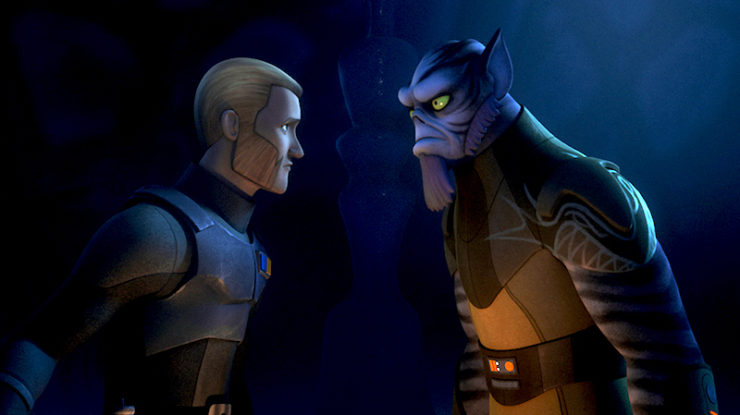
In the original trilogy we know that the Empire is bad; they are willing to commit genocide to prove said badness. But we don’t know the smaller ins and outs of their system, or really anything about the people who elect to be a part of it. Rebels not only lets us see more of the inner workings of the Empire—from how they occupy planets to how they develop their new ships and weapons—but also lets us key into the effect the Empire has on individual lives. It does this through two central characters: Garrazeb Orrelios and Alexsandr Kallus.
Zeb, as he’s known to the Ghost crew, is a former member of the Lasat Honor Guard. He’s the muscle of the crew, much like Chewie is for Han. But unlike the Wookiees, who were enslaved by the Empire, Zeb’s people were completely wiped out by them. He is a survivor of genocide, with no planet or people to call his own. Though he seems rough on the outside, the more we learn about Zeb, the more we see how the loss of his planet has effected him. (He’s also not so tough. He’s pretty snuggly at the end of the day.)
Agent Kallus is a member of ISB—the Imperial Security Bureau—and one of the first major players tasked with rooting out our rebel crew. But rather than make him a blind antagonist, the show reveals Kallus to be a more complicated person, with a different morality than the one might expect of an Imperial officer. Together, both of these characters develop (and often intersect) in surprising ways that make the series a better exploration of the usual good guy/bad guy dynamic that Star Wars can pair down to.
The Mandalorians Are Back to Their Old Tricks
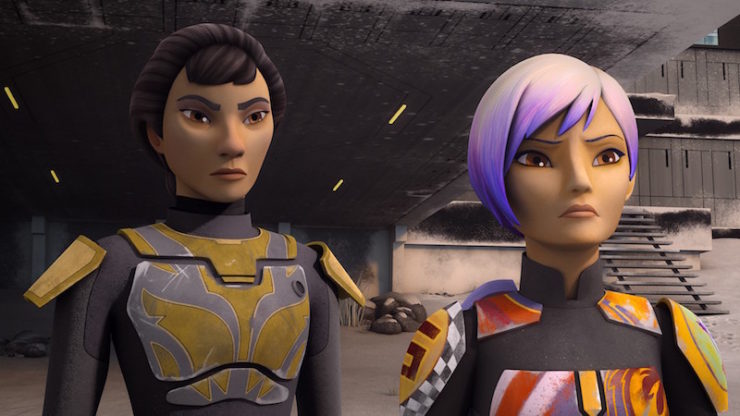
Fans of the erstwhile Legends canon were pretty upset when the Clone Wars series turned around and made their favorite armor-wearing walking arsenals into pacifists who had put their rough days behind them. (Count me among their number, as a big fan of what Karen Traviss did with the culture in her Star Wars novels.) But Rebels shows a Mandalore beset by the Empire and returning to its roots in the more ways than one. The main way the show engages with this is through Sabine Wren, a former Imperial cadet from House Viszla, who turns her back on the Empire and uses armaments and art to bring down facism.
Sabine is… everything. With her color-changing hair and her gorgeous graffiti habit, she is exactly what Mandalorian-obssessed teenage me wanted from Star Wars and never got. But what’s better is how the narrative allows Sabine to develop at her own pace. We’re a few seasons into the show before we get proper backstory on her family and why she left the Imperial Academy. Because she’s a teenager and she behaves like one; not really interested in letting anyone in unless she knows them well and feels like sharing in the moment. And yes, she’s hyper-competent, but she’s also still allowed to be young and to learn (and also allowed to not get paired off with someone just because she’s another young female character).
The Mandalorians we encounter in this series are a proud people who are making some mistakes in their dealings with the Empire. But most importantly, they are far more like the gruff, honorable warrior culture that Star Wars fans used to treasure. Plus, you know, jetpacks.
The Expanded Universe’s Best Villain is Here to Cause Trouble

If you read Star Wars books in the ’90s and early ’00s, you couldn’t forget Grand Admiral Thrawn. Created by author Timothy Zahn, Thrawn was one of the few Star Wars villains who seemed genuinely dangerous. The fact that he was a genius certainly helped, but so did the fact that he behaved like a clever predator, patiently stalking his prey.
Star Wars: Rebels made the choice to reintroduce Thrawn to canon.
The best thing about this choice is watching how Thrawn interacts with Imperial High Command in his heyday. Fans of the character only knew him as a commander who survived the end of the Empire and went on to make more trouble for the New Republic. But now we get to see the man in his element. We get to watch how he handled the emerging Rebel Alliance, and how he commanded when he was still answering to the Emperor.
This is more important because the Original Trilogy is keen on showing us an Empire full of blustering middlemen who either bicker constantly, or have difficulty looking their superiors in the eye. Thrawn is an antidote to this; he shows the audience how terrifying the Empire can be when controlled by someone who knows what they’re doing.
These are just a few reasons you should watch Star Wars: Rebels, if you aren’t already. There are a lot more, to be honest. And now that the show is ending, you can get right to it!
Emmet Asher-Perrin really needed this show over the past few months, and is trying to figure out how to cope now that it’s all coming to an end. You can bug her on Twitter and Tumblr, and read more of her work here and elsewhere.










